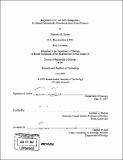Regulation of E. coli SOS mutagenesis by dimeric intrinsically disordered umuD gene products
Author(s)
Simon, Sharotka M. (Sharotka Maria)
DownloadFull printable version (21.27Mb)
Other Contributors
Massachusetts Institute of Technology. Dept. of Biology.
Advisor
Graham C. Walker.
Terms of use
Metadata
Show full item recordAbstract
Products of the umuD gene in E. coli are involved in regulating the timing of error-free DNA repair processes and mutagenic translesion DNA synthesis (TLS) during the SOS response to DNA damage. Homodimeric UmuD2 is upregulated early during the SOS response, and a slow post-translational autocleavage process removes the N-terminal 24 amino acids of each UmuD monomer. The remaining C-terminal fragment, UmuD'2, activates the catalytic subunit of the Y family DNA polymerase V for mutagenic TLS. The small proteins UmuD2 and UmuD'2 make a large number of specific protein-protein contacts for their roles in regulation. This report chronicles experiments that indicate that umuD gene products share characteristics with intrinsically disordered proteins, which lack a defined secondary or tertiary structure when purified and many of which have important roles in regulation. Counterintuitively, UmuD2 and UmuD'2 form stable homodimers in vitro at concentrations where little or no a helix or 13 sheet is detectable. High protein concentrations and certain crowding agents can confer more typical secondary structure on UmuD2 and UmuD'2. (cont.) The binding affinities between UmuD2 and two of its interaction partners are reported; interaction with either of these interaction partners also confers secondary structure on UmuD2. Intrinsic disorder in umuD gene products helps explain how they can make a vast number of specific protein-protein interactions despite their small size, and previous single-cysteine studies of both UmuD2 and UmuD'2 provide insights into the actual structures of intrinsically disordered proteins. A model is presented for how umuD gene products and certain hub proteins, which form highly connected nodes in protein-protein interactomes, can make sequential protein-protein interactions.
Description
Thesis (Ph. D.)--Massachusetts Institute of Technology, Dept. of Biology, 2007. Includes bibliographical references (p. 202-222).
Date issued
2007Department
Massachusetts Institute of Technology. Department of BiologyPublisher
Massachusetts Institute of Technology
Keywords
Biology.